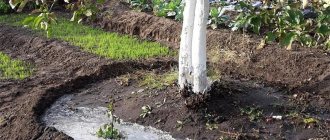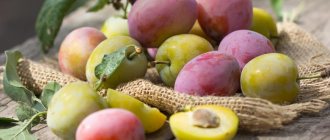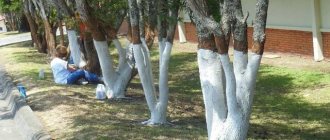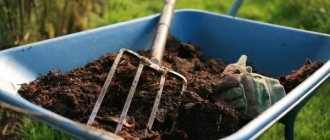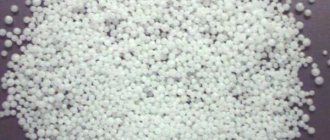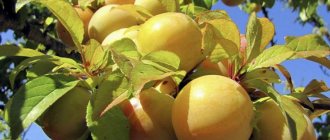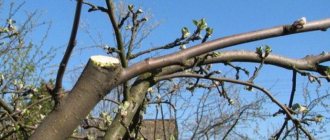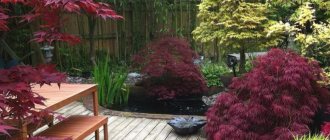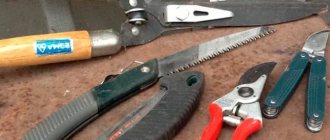Correctly done pruning can keep the plant strong, strong and beautiful. In fruit trees, the quality and quantity of the harvest is significantly improved. The most suitable time for circumcision is the end of winter and the beginning of spring. At this time, the plant is dormant, all growth processes are still very slow, and the wood is no longer frozen. In this article we will look at the types of pruning of fruit trees and find out when it is better to prune them - in spring or autumn.
Timing for pruning trees in spring
An important question in tree pruning is when exactly to do it. If this procedure is carried out too early, while temperatures are still low, the tree may not tolerate frost. If you delay pruning until the sap begins to flow, the plant will “cry” for a long time.
Latest articles about gardening
Treatment of fruit trees and shrubs in spring with urea
Seedlings without soil on toilet paper video
Coffee grounds as fertilizer for indoor plants
The ideal weather for mowing the garden is clear, slightly frosty, with an air temperature not lower than –5°C. In the middle zone, the timing of tree pruning in spring is usually limited to the period from mid-March to mid-April.
When to prune fruit trees: choosing timing
The time for working with fruit trees is chosen taking into account causing the least harm to the crops. Any pruning causes wounds to the branches, so it is important to minimize the leakage of sap and drying out.
Main periods:
- spring - before sap flow begins. It’s difficult to give exact dates; a lot depends on weather conditions. In the Moscow region, if the weather is suitable, pruning is usually planned for the second half of March, taking into account the weather forecast for a particular season. The main condition is positive air temperatures, when the wood is pliable and not so prone to cracks;
- autumn - after leaf fall. Although in the fall it is recommended to work with trees in the southern regions, where winters are not so severe. Pruning in the fall reduces the winter hardiness of crops, so they are usually content with removing diseased and deformed shoots, leaving the formation of the crown until the spring.
On a note!
It is prohibited to carry out work in the spring, during the period from blossoming to complete unfolding of leaves. At this time, plants are most vulnerable.
In the summer, trees are pruned if necessary, for example, tops (fatifying shoots that do not bear fruit) and diseased branches are removed. At the same time, they try to cut out only small specimens, leaving large ones until spring.
Timing for pruning trees in autumn
Regarding autumn pruning:
It is carried out after the leaves have fallen. Dried, broken, rotten branches, also those that grow in the wrong direction, are pruned.
If the tree has grown very actively and the crown does not allow enough light to pass through, then additional summer pruning is carried out.
It is advisable to provide for these moments in the spring, since then the tree is at rest and can more easily tolerate the procedure.
An important point: winter pruning is carried out only in regions with a warm climate, since in the cold the branches may be too fragile and break, which will damage the bark. The same point should be taken into account when pruning in autumn. The procedure must be completed before the first frost.
Treatment and care after pruning
The pruning procedure is very traumatic for the tree, so the activities carried out after pruning are very important.
If the cut has a circumference of more than 1 cm, then after trimming it must be thoroughly processed: disinfected with alcohol, a weak solution of potassium permanganate, or a 3% solution of Bordeaux mixture.
After a few hours or the next day, the cut should be covered with garden pitch, manure-clay mixture or cement mortar. This will promote rapid healing of the wound. If the cut is large in diameter—more than 15 cm—you need to cover the wound with a rag.
Existing types of tree pruning
To rejuvenate trees and shrubs, different types of pruning are used, there are about five of them, and combination is also possible.
- The first type is formative. Initially, you need to give the desired shape and size to the crown. But you need to know how to prune fruit trees correctly. All excess branches are cut off at the very trunk, large ones - by a third, thin ones - by half.
- The second type is regulatory. Aimed at maintaining a balance between crown growth and fruiting. All vertical, skeletal branches and shoots inside the tree are trimmed. Such actions will give the crown the shape of a pyramid.
- The third type is rejuvenating. This pruning is carried out to maximize the growth of all branches (old and young).
- The fourth type is restorative. If the tree or its branches have been subjected to frost or mechanical damage, then partial pruning is carried out.
- The fifth type is sanitary. This is pruning of damaged, diseased, dry or broken branches. In practice, gardeners often combine all types of rejuvenation.
How to prune trees to get a good harvest
To obtain a bountiful harvest, you should thin out the tree crown. This will allow the fetus to receive the amount of sunlight necessary for growth. But not everyone can do it correctly.
Currently, gardeners practice several methods of crown pruning. By giving the optimal shape to the crown of various crops, it is possible to increase plant productivity several times.
For example, a bushy crown is more suitable for plums and peaches. The shape of such a crown resembles a ball. This allows the tree to better withstand winter frosts and, accordingly, bear fruit better.
For apple and pear trees, a pyramidal crown is more suitable. This allows the fruits not only to grow better, but also affects their taste.
The free form of the crown is suitable for quince. The plant is pruned only to remove dry or diseased branches. Otherwise, it grows as Mother Nature wishes.
What is the purpose of pruning fruit and berry plants?
Fruit trees and shrubs are planted to produce a harvest. This is their main purpose, although many of them look extremely decorative. Proper and regular pruning significantly increases productivity. This happens because the branches remaining from pruning are well lit and ventilated, and the bush or tree acquires the most successful crown shape.
In the process of regular pruning, the tree also gets rid of diseased branches in time and the infection does not have time to spread to the entire plant.
Yield regulation also occurs through pruning. Some of the fruiting branches are removed so that the remaining ones bear the maximum number of large and healthy fruits. In the absence of this operation, the tree in most cases cannot provide adequate nutrition to all the formed ovaries. The fruits are small, and sometimes the crop is partially or completely destroyed.
Principles of spring tree pruning
Planning garden work “When is the best time to prune fruit trees in the spring” also depends on the neglect and density of the garden. In addition, during the winter some branches could break, others could split under the snow that had settled on them. Then a “haircut” is inevitable. If there are no visible injuries, then pruning can be neglected. Only a small correction will be required to form the crown.
According to the general principles of forming a fruit-bearing, strong plant, when “trimming” the following is removed:
- inclined branches extending from the trunk at an acute angle;
- curved shoots directed towards the middle of the crown;
- non-fruit-bearing branches (based on the yield results of previous years) or too long, curved;
- part of the crown that is inclined to the ground and interferes with cultivation of the soil under the tree and watering.
Why pruning of fruit trees is carried out during the dormant period of plants
The main pruning of plants is carried out in early spring or late autumn, during the dormant period. There are several reasons for this:
- this is the time when the plant most easily survives such a complex operation as pruning;
- since there is no sap flow, the plant does not lose juice when pruned;
- the skeletal branches are clearly visible, since there are no leaves, and pruning is easy.
Trees should be pruned during the dormant period, at the end of winter. At this time, the skeletal branches are clearly visible.
Autumn tree pruning
In order for a tree to survive the winter well, it must be provided with some kind of comfortable conditions. The main task pursued when pruning fruit trees in autumn is to remove all excess that will interfere with the normal development of the tree. First of all, this applies to diseased, old, dry branches, which are a habitat for various pests. All branches with fungus and lichen must be removed. It would be a good idea to treat the trees with iron sulfate. If there are intertwined branches on the trees, they are also removed. The same applies to unnecessary growth.
Similarly, attention is paid to the tops: if they dry out, or they are completely dry, or there are diseased parts, it is necessary to remove the living tissue of the tree. If there are branches on the tree that could break with a strong gust, causing damage to the tree, they need to be removed. For pruning, depending on the diameter of the branches, a hacksaw or pruning shears is used. After pruning, all sections must be treated with an antiseptic.
Required Tools
Many gardeners perceive pruning as one of the important elements of proper care of fruit trees. To carry out this process, special tools are required:
- Garden pruning shears - it should be very convenient and simple. It is not advisable to buy a tool that has a ratcheting mechanism, since due to this design feature it is impossible to get a perfectly even cut the first time.
- A pruning saw is a regular hacksaw that resembles a saber that tapers at the end. Under no circumstances should you use a standard construction saw instead, only a tool with a special profile.
- Secateurs for trimming the upper branches with an attachment for a long stick. It is activated using levers and rope. This design helps to reach the branches located at the very top of the tree.
After purchasing a tool, you must keep it clean and ensure that it is always sharpened.
Only in this case there will be no torn sections into which various infections and microorganisms can easily penetrate. After each pruning procedure, the tool must be cleaned and lubricated with a cloth soaked in machine oil.
When should you prune trees?
Many gardeners do not pay attention to the timing of when fruit trees should be pruned, which is completely wrong.
It is important not to harm the plants, so it is best to do this in the spring. The optimal period is the end of February or the beginning of March, when severe frosts are no longer expected
The optimal period is the end of February or the beginning of March, when severe frosts are no longer expected
It is important not to harm the plants, so it is best to do this in the spring. The optimal period is the end of February or the beginning of March, when severe frosts are no longer expected
The first to start cutting are:
- apple tree;
- pear.
The remaining fruit trees and shrubs are subjected to this procedure at the end of the first month of spring or the beginning of the second. First of all, pome crops are pruned, and only after that - plants with stone fruits.
If the trees have not yet become stronger, then this must be done before the sap begins to flow, as this will subsequently weaken them and they will begin to hurt.
If necessary, at the beginning of June, fully mature flowering trees and shrubs are pruned, which will normally tolerate this procedure even after the sap circulation has ended.
How to carry out cutting technology correctly
Pruning of fruit crops is carried out in different ways. Let's look at the most basic ones.
Making a cut on the kidney. This method allows you to choose the direction of branch growth in the direction that the gardener needs. For these purposes, only growth-bearing one-year-old shoots are used, from which a bud growing in the desired direction is selected.
The pruning shears are positioned so that its cutting part is located near the part of the branch that is being left, and not near the end that is being cut off. The cut is made at an angle so that this bud remains untouched. If the cut is too sharp, the bud will be deprived of the required amount of nutrients and will dry out.
Ring cut. In this case, the branch growing in the wrong direction is completely pruned. It not only takes away nutrition from fruiting shoots, but is also completely useless.
If the thickness of the branch being cut is small, it is best to use pruning shears. The cut is made along the outer edge of the rings, which form a bead on the bark at the place where the branches connect.
Cut to form a side branch. It is carried out when a transition of growth from one branch to another is required. In this case, the unnecessary branch is deleted completely. The resulting cut seems to continue the left branch, as a result of which the side one becomes the main one.
Schemes for pruning pear, cherry, and apple trees in spring
- Pruning fruit trees in spring: scheme for pears:
In winter, the branches freeze and tops appear. They are completely removed or trimmed.
If you prune too much, it will weaken the tree and the fruit will appear much later than expected. It is better to do moderate pruning.
It is useful to slightly shorten annual branches. This will only strengthen them.
- For apple trees:
Before you start pruning, you need to clear the trunk and main branches of shoots.
Removing a third of the branches and shoots will rejuvenate the old plant and increase productivity - the main thing is not to overdo it.
Pruning needs to be done over several years.
- For cherries, sweet cherries:
Five to seven strong branches are left in young trees, “looking” in different directions. The distance between them is up to 10 centimeters.
All weak branches are removed.
The conductor should be 20 centimeters longer than the others.
Cherries are pruned only in the spring.
Autumn pruning of apple tree
The goal is to eliminate weak, dry, diseased branches of apple trees with signs of rotting, black cancer, and other dangerous conditions. Don’t worry, you won’t do any harm, since during this period the plant is already in a dormant state.
Action plan:
- Start with older, larger branches that are dead or severely damaged.
- Start removing branches that grow at an acute angle.
- All cut areas are covered with garden varnish; if this is not available, then use drying oil paint. Young branches are not treated immediately, but after a day.
- Burn all cut shoots and twigs.
Recommendations for the circumcision process
Beginning gardeners are interested in how to prune each specific tree, because the methods vary depending not only on the species, but also on the variety. For example, when pruning walnuts, mulberries and grapes, most often only dried shoots that interfere with growth are removed. Each vine requires active and painstaking attention. Pruning of stone fruits (cherries, cherries, apricots) begins with fruit-bearing specimens in order to do so before the awakening of stone fruit buds, which wake up earlier than vegetative ones.
Tree pruning in spring
One-year-old growths (last year's shoots) must be pruned every year or at least every other year. By combining cutting and pruning, you can achieve a neat and strong crown. In the process of pruning growths, moderation is needed, otherwise young trees will lose fruitfulness by forming unnecessary skeletal branches that choke the fruit branches. This also risks the fact that next season the gardener will have to tinker more with trimming excess branches, fearing that they will thicken the crown and reduce cold tolerance.
It should be remembered that intensive pruning is only necessary if it is necessary to weaken individual branches that are beginning to compete with the conductors or could potentially interfere with other smaller branches. Do not prune branches that have regained a horizontal position after gartering; pruning should also be avoided in cases where it concerns powerful intermediate branches that are in a horizontal position. If you do not follow these rules, the gardener will absolutely unreasonably delay the appearance of fruits on pruned branches and reduce their number.
Pruning of such representatives of garden flora as pears and apple trees must begin in mid-spring, trying to do it before the juice begins to circulate. If the growth from last year reaches half a meter in size and looks healthy, then this is good and there is no need to touch anything. If they have barely reached the 18-20 cm mark, then you need to start by looking for a problem that affects the general condition of the plant. For example, the reason for this may be branches that extend from the tree trunk at sharp angles. Remember that a tree should have one top, and feel free to eliminate them.
Skeletal branches, if they overtake each other in growth, can become a potential problem in the future, so they should be pruned in tiers. Calculate so that one tier is 16 cm lower than the previous one. Having finished pruning, move on to annual shoots; they need to be cut by about a third of their length so that there are no difficulties with branching in the future.
A special approach is required for those trees that form a crown in the form of a pyramid. When pruning, try not to touch the topmost bud, which is most often located on the outside. If the tree is spreading, then, on the contrary, a bud is left on the inner side. The powerful branches of the pyramidal tree are directed outward when pruned. Those branches that grow at an acute angle are eliminated almost to the base; in extreme cases, leave 20 cm of shoots under the “stump”.

